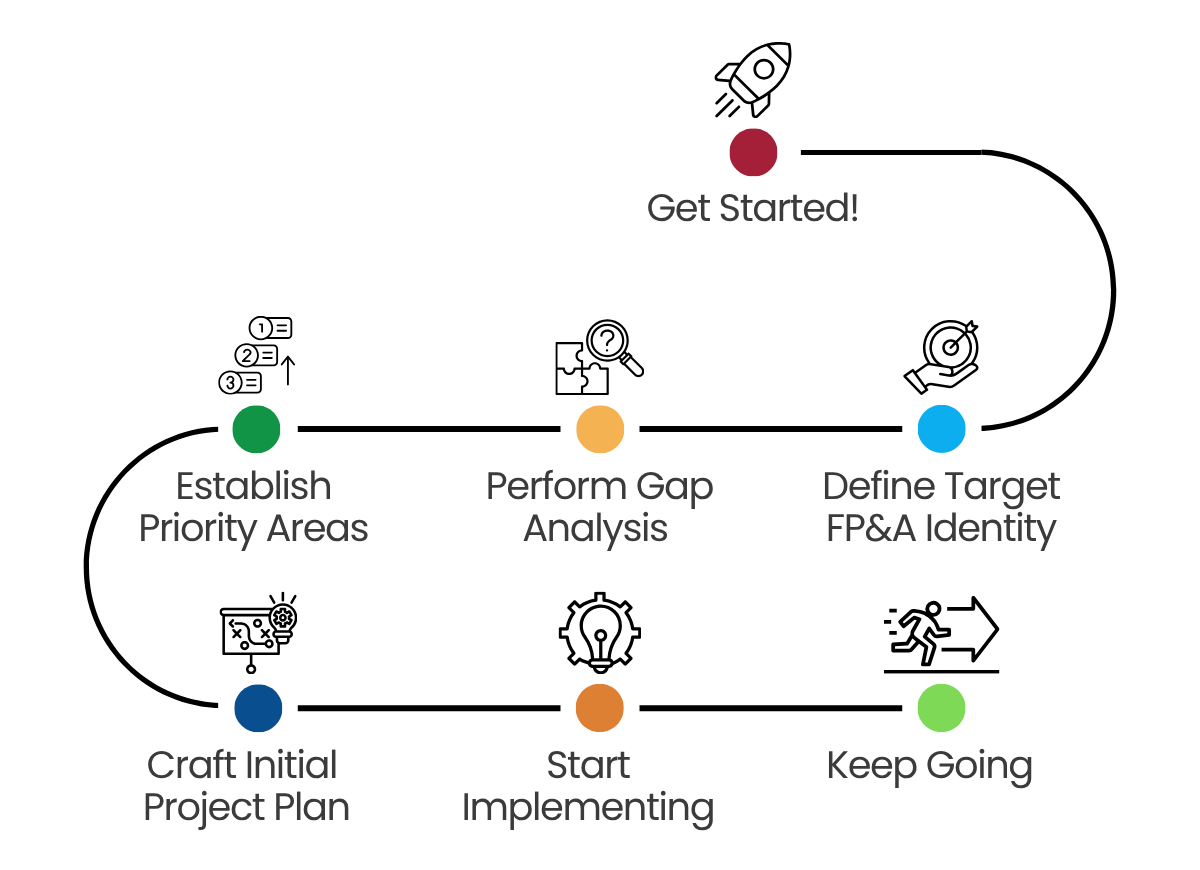Discover how FP&A professionals can lead digital transformation by integrating AI, Power BI, automation and continuous...

FP&A’s Growth Trajectory & Sprawl
Most of us would probably agree that FP&A has grown tremendously in what really is its relatively short lifetime. FP&A’s impressive growth trend brings with it a deserved element of satisfaction in that it seems to suggest that FP&A’s increased organisational relevance must, to some significant extent, derive from its ability to add value.
The news gets even better from here as current and emerging thought leaders demonstrate resolve to keep FP&A moving forward. In other words, there is real momentum, and there does not seem to be much standing still or resting on laurels. This is great to see, but where does FP&A go next?
Understanding our future destination requires some amount of prerequisite self-awareness about how we got to the current state. In my view, one aspect of FP&A growth is that it has involved some amount of sprawl. That is, unplanned growth. Growth that just happened. We can also call it situational growth.
The demand for FP&A services was certainly there, and the FP&A supply chain evolved as best it could to address the needs in what has become a very challenging set of tasks for FP&A leaders to manage. As demand increased, FP&A took on more and varied tasks - many of them routine, cyclical, and data-oriented.
Exhibiting the sprawl is the fact that FP&A has come to mean many different things in many different organisations. Additionally, the lack of a more formal and codified set of standards for FP&A and the absence of unified or widely available FP&A university course curricula left growth open to evolve as it did.
One only needs to look at a sampling of current FP&A job postings to see the amount of “verticality” that is now expected of FP&A professionals. The “verticality” ranges from very tool-specific high-volume data handling to providing strategic game-changing input, while at the same time, taking cross-functional collaboration to new heights!
It becomes a tough set of often-competing requirements that is indicative of the sprawl. As a result, it becomes very difficult to leverage and “train-up” for something that by definition is all over the place and/or ambiguous.
Strategic Road-Mapping & Enabling Focus
FP&A now faces a tangled network of crossroads and interlocking as well as disparate “pieces and parts” that it must now move to reconcile. In other words, FP&A increasingly needs to pick its spots - where it most wants and needs to be and then develop strategies to fill its gaps to enable increased focus on its value adds. Enabling focus is key.
Making the road-mapping and resulting set of journeys even more challenging is that the daily hum of the business engine continues. As uncomfortable as it sounds, this roadmap and set of journeys will take time and needs to be done on the fly. Not doing it means that the sprawl remains, and available work effort is suboptimised or mistargeted versus the desired mix, thus keeping FP&A from being all it can be.
Figure 1 outlines the seven essential steps FP&A leaders can take to move from sprawl to strategy. Each step provides practical direction for building a focused, value-adding FP&A function while still managing day-to-day business needs.

Get Started!
Do not miss this often-overlooked step. Of course, you will not have all the answers. But neither does anyone else! Better to get the ball rolling now. You will be directionally in the ballpark and figure the rest out as you go. Your view of the playing field is good enough to get started and do something rather than nothing. Get input from the business and other key internal customers, including IT. Socialise with your FP&A team for additional input and buy-in.
Define Target FP&A Identity
It is the initial visioning step for what FP&A should look like in the future. Again, you may have just part of the answer at this point, but defining a future state is essential. The forward look will certainly vary across organisations, but current wisdom is that FP&A organisations are looking to focus more on business partnering and strategic insights than data handling. This is where a first new look at an evolved FP&A mix is rendered. Fixing sprawl requires clarity.
Perform Gap Analysis
Evaluate the present state factors vs. the target FP&A identity. Where are the gaps? Be realistic and honest in assessing where current skills, tools, and processes stand. Skill gaps may include hiring, training, and/or reorganisation needs. While a broader systems/tools review is advised at this step, be sure to include how current AI use compares to what is needed in the target state. Finally, building higher-level capabilities and focus requires foundationally solid processes.
Establish Priority Areas
The gap analysis will most likely provide valuable information as to where there are significant gaps and where the gaps are small or maybe even non-existent. Being careful to retain the goodness of FP&A functions and activities that are working well, establish priority areas and rough timelines for the path forward to the future state. Priority areas should seek to close gaps and alter FP&A activity mix as needed.
Craft Initial Project Plan
Sketch an initial plan listing the key priority areas, activities, milestones, and timelines. Rough dollars for required investment are helpful at this stage, too. This plan does not initially have to be very formal at all. Complexity, scope, resource needs, and enterprise size/culture will help determine if this set of journeys needs to be a formally-chartered transformation project with a project manager vs. just being a formidable to-do list, or something in between.
Start Implementing
Follow the plan, but grab low-hanging fruit where possible. Implement less costly and/or “easy button” plan elements to get some early wins while you better organise for harder and/or more costly elements ahead. Build momentum, earn trust, socialise project/activities, and continue cultivating support and buy-in. Again, you will not have every implementation answer at this point, nor be able to do everything now. But often these seemingly small wins add up.
Keep Going
Whatever you do, keep going. No one said this was going to be easy. Track lessons learned. Refine, refocus, and regenerate. Whether great or small in project complexity, scope and size, transformation efforts are iterative. Keep an eye on the prize and evaluate progress vs. the target state of making your version of FP&A all it can be. Achieving FP&A’s target mix and therefore building a higher-level FP&A capability is key. Be prepared to invest. Remain vigilant.
Where The Rubber Hits The Roadmap
Verizon FP&A embarked on a 24-wave, 16 to 18 month journey in which it employed work standardisation and automation, invested in advanced analytics and cloud-based systems, automated routine data tasks and report generation, and centralised key functions, including planning model ownership and maintenance in its FP&A COE. These steps enabled the focus to foster the strategic thinking and enhanced skills needed to support increased business partnerships.
At Microsoft, FP&A utilised the strength of its Power Platform to help accelerate FP&A transformation. More specifically, it standardised and scaled work processes, leveraged shared data and more intuitive tools, as well as embedded AI and automation into core FP&A functions such as forecasting and scenario planning. This reduced the time spent on data and manual reporting processes, which in turn created the focus needed to upskill for heightened strategic business partnering and for faster, more informed decision-making across its global business units.
Summary
- Pointing FP&A towards its next steps and getting there is hard but essential work.
- It is recognised that many organisations and FP&A leaders are already well along their journey map paths and are indeed defining and pursuing the next-gen FP&A state.
- All FP&A leaders should feel confident that they understand their organisations well enough to move forward now.
- Reorganising FP&A work and effort to navigate/reduce FP&A sprawl and to change the FP&A mix toward higher-level activities like business partnering and providing strategic insights remain clear-cut winners.
- AI remains a wild card in its usefulness and placement in FP&A’s upcoming journeys. It is important that we use AI rather than let AI use us.
Takeaway for FP&A Leaders: When FP&A work is scattered, it’s hard to add real value. Verizon shows that bringing everything together in one place, standardising the basics, and freeing up time with automation creates space for the team to finally focus on strategy.
Takeaway for FP&A Leaders: Microsoft proves that FP&A doesn’t have to be stuck in spreadsheets and manual reporting. By leaning on automation, AI, and better tools — while also investing in people — FP&A can step up as a true partner to the business, helping leaders make faster, smarter decisions.
Sources:
1. Why and How I built an FP&A Center of Excellence at Verizon - Ed Hyer - Datarails
2. Microsoft Journey: Becoming Next-Gen Finance Business Partners | FP&A Trends
3. ey-gl-how-ai-is-transforming-fpa-06-2025.pdf
4. How Microsoft Evolved to FP&A 2.0 // Collectiv Conversations
5. Microsoft Finance Digital Transformation, KPMG CFO Roundtable: PowerPoint Presentation
Subscribe to
FP&A Trends Digest

We will regularly update you on the latest trends and developments in FP&A. Take the opportunity to have articles written by finance thought leaders delivered directly to your inbox; watch compelling webinars; connect with like-minded professionals; and become a part of our global community.






